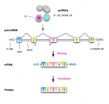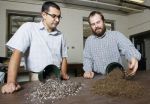(Press-News.org) PHILADELPHIA - When most genes are transcribed, the nascent RNAs they produce are not quite ready to be translated into proteins - they have to be processed first. One of those processes is called splicing, a mechanism by which non-coding gene sequences are removed and the remaining protein-coding sequences are joined together to form a final, mature messenger RNA (mRNA), which contains the recipe for making a protein.
For years, researchers have understood the roles played by the molecular machines that carry out the splicing process. But, as it turns out, one of those familiar components plays a new, and altogether unexpected role.
As senior author Gideon Dreyfuss, PhD, the Isaac Norris Professor of Biochemistry and Biophysics at the University of Pennsylvania School of Medicine and colleagues report in Nature, one of the splicing machinery's components called U1 has a second, equally important role in gene expression: To enable gene sequences to be read out into their RNA transcripts in their entirety, rather than have that process prematurely stopped. Dreyfuss is also a Howard Hughes Medical Institute Investigator.
The researchers revealed an unexpected function for U1 in protecting mRNA transcripts from premature termination in addition to and independent of its role in splicing.
As Dreyfuss puts it, "U1 is a guardian of the transcriptome." The transcriptome is the set of all RNA molecules in one cell.
U1 is one of a collection of RNA-protein complexes, called snRNPs, that recognize splicing junctions, excise non-coding gene sequences called introns, and join the remaining coding sequences called exons together. The Dreyfuss team previously showed that loss of SMN, a protein that helps assemble snRNPs and is deficient in individuals with the common neurodegenerative disease spinal muscular atrophy (SMA), results in altered snRNP levels and abnormal splicing.
SMN deficiency affects all snRNPs to one degree or another. The Dreyfuss team wanted to find out what would happen if just one snRNP was missing. They started with U1.
The team's expectation was that they would detect an increase in unspliced RNA transcripts, and indeed they saw evidence of that. But, to their surprise, the majority of the genes produced a very different and striking result. Their transcripts terminated prematurely and abruptly, generally within a relatively short distance from the transcription start site of the gene.
When they sequenced the ends of the resulting truncated RNAs, they found that they had been prematurely cleaved and tagged with a long string of nucleotide building blocks called adenine. This string is a hallmark of a process called cleavage-and-polyadenylation, which normally occurs at the end of a gene's RNA transcript. The lack of U1 was causing the cleavage/polyadenylation machinery to kick into gear early.
The implication, Dreyfuss says, is that U1's normal role, in addition to splicing, is to keep the cleavage/polyadenylation machinery in check until the RNA polymerase enzyme that synthesizes the transcript reaches its finish line. The researchers propose a model in which U1 binds throughout the nascent RNA transcripts, stymieing the cleavage/polyadenylation machinery that tags along with the moving polymerase complex. This in turn protects the many potential polyadenylation signals encountered along the way, and could explain the relative abundance of U1 in cells compared to other snRNPs. The additional U1 corresponds to the greater amount needed for its additional function.
"The transcripts are under constant threat from the cleavage/polyadenylation machinery," Dreyfuss explains. "This machinery doesn't patiently wait for the transcript to reach the end of the gene; rather, the nascent RNA transcripts are subject to becoming attacked by this machinery. It's a constant danger they face, and the U1 snRNP suppresses it."
It is, he says, "a novel role" for U1, and a critical component for correctly making mRNA. "It is essential for the integrity of the transcriptome, the landscape of all mRNA molecules in the cell," he concludes.
INFORMATION:
Other coauthors on the paper include Penn researchers Daisuke Kaida, Michael Berg, Ihab Younis, Mumtaz Kasim, Larry Singh, and Lili Wan. The research was funded by the Association Française Contre les Myopathies and the Howard Hughes Medical Institute.
Penn Medicine is one of the world's leading academic medical centers, dedicated to the related missions of medical education, biomedical research, and excellence in patient care. Penn Medicine consists of the University of Pennsylvania School of Medicine (founded in 1765 as the nation's first medical school) and the University of Pennsylvania Health System, which together form a $3.6 billion enterprise.
Penn's School of Medicine is currently ranked #2 in U.S. News & World Report's survey of research-oriented medical schools, and is consistently among the nation's top recipients of funding from the National Institutes of Health, with $367.2 million awarded in the 2008 fiscal year.
Penn Medicine's patient care facilities include:
The Hospital of the University of Pennsylvania – the nation's first teaching hospital, recognized as one of the nation's top 10 hospitals by U.S. News & World Report.
Penn Presbyterian Medical Center – named one of the top 100 hospitals for cardiovascular care by Thomson Reuters for six years.
Pennsylvania Hospital – the nation's first hospital, founded in 1751, nationally recognized for excellence in orthopaedics, obstetrics & gynecology, and psychiatry & behavioral health.
Additional patient care facilities and services include Penn Medicine at Rittenhouse, a Philadelphia campus offering inpatient rehabilitation and outpatient care in many specialties; as well as a primary care provider network; a faculty practice plan; home care and hospice services; and several multispecialty outpatient facilities across the Philadelphia region.
Penn Medicine is committed to improving lives and health through a variety of community-based programs and activities. In fiscal year 2009, Penn Medicine provided $733.5 million to benefit our community.
Penn study identifies molecular guardian of cell's RNA
2010-10-26
ELSE PRESS RELEASES FROM THIS DATE:
UI study investigates variability in men's recall of sexual cues
2010-10-26
Even if a woman is perfectly clear in expressing sexual interest or rejection, young men vary in their ability to remember the cues, a new University of Iowa study shows.
Overall, college-age men were quite good at recalling whether their female peers – in this case, represented through photos – showed interest. Their memories were especially sharp if the model happened to be good looking, dressed more provocatively, and conveyed interest through an inviting expression or posture.
But as researchers examined variations in sexual-cue recall, they found two noteworthy ...
Genetic markers offer new clues about how malaria mosquitoes evade eradication
2010-10-26
VIDEO:
Boston College DeLuca Professor of Biology Marc A.T. Muskavitch discusses his latest malaria research, published in the journal Science. Muskavitch and an international team of researchers developed the first high-resolution...
Click here for more information.
CHESTNUT HILL, Mass. (10/25/2010) – The development and first use of a high-density SNP array for the malaria vector mosquito have established 400,000 genetic markers capable of revealing new insights into how ...
Microwave oven key to self-assembly process meeting semi-conductor industry need
2010-10-26
Thanks to a microwave oven, the fundamental nanotechnology process of self assembly may soon replace the lithographic processing use to make the ubiquitous semi-conductor chips. By using microwaves, researchers at Canada's National Institute for Nanotechnology (NINT) and the University of Alberta have dramatically decreased the cooking time for a specific molecular self-assembly process used to assemble block copolymers, and have now made it a viable alternative to the conventional lithography process for use in patterning semi-conductors. When the team of chemists and ...
Heat acclimation benefits athletic performance
2010-10-26
Turning up the heat might be the best thing for athletes competing in cool weather, according to a new study by human physiology researchers at the University of Oregon.
Published in the October issue of the Journal of Applied Physiology, the paper examined the impact of heat acclimation to improve athletic performance in hot and cool environments.
Researchers conducted exercise tests on 12 highly trained cyclists -- 10 males and two females -- before and after a 10-day heat acclimation program. Participants underwent physiological and performance tests under both ...
Unexpected findings of lead exposure may lead to treating blindness
2010-10-26
HOUSTON, Oct. 25, 2010 – Some unexpected effects of lead exposure that may one day help prevent and reverse blindness have been uncovered by a University of Houston (UH) professor and his team.
Donald A. Fox, a professor of vision sciences in UH's College of Optometry (UHCO), described his team's findings in a paper titled "Low-Level Gestational Lead Exposure Increases Retinal Progenitor Cell Proliferation and Rod Photoreceptor and Bipolar Cell Neurogenesis in Mice," published recently online in Environmental Health Perspectives and soon to be published in the print ...
Rice hulls a sustainable drainage option for greenhouse growers
2010-10-26
WEST LAFAYETTE, Ind. - Greenhouse plant growers can substitute rice hulls for perlite in their media without the need for an increase in growth regulators, according to a Purdue University study.
Growing media for ornamental plants often consists of a soilless mix of peat and perlite, a processed mineral used to increase drainage. Growers also regularly use plant-growth regulators to ensure consistent and desired plant characteristics such as height to meet market demands. Organic substitutes for perlite like tree bark have proven difficult because they absorb the plant-growth ...
As Arctic warms, increased shipping likely to accelerate climate change
2010-10-26
As the ice-capped Arctic Ocean warms, ship traffic will increase at the top of the world. And if the sea ice continues to decline, a new route connecting international trading partners may emerge -- but not without significant repercussions to climate, according to a U.S. and Canadian research team that includes a University of Delaware scientist.
Growing Arctic ship traffic will bring with it air pollution that has the potential to accelerate climate change in the world's northern reaches. And it's more than a greenhouse gas problem -- engine exhaust particles could ...
UF research gives clues about carbon dioxide patterns at end of Ice Age
2010-10-26
GAINESVILLE, Fla. — New University of Florida research puts to rest the mystery of where old carbon was stored during the last glacial period. It turns out it ended up in the icy waters of the Southern Ocean near Antarctica.
The findings have implications for modern-day global warming, said Ellen Martin, a UF geological sciences professor and an author of the paper, which is published in this week's journal Nature Geoscience.
"It helps us understand how the carbon cycle works, which is important for understanding future global warming scenarios," she said. "Ultimately, ...
Purdue-led research team finds Haiti quake caused by unknown fault
2010-10-26
WEST LAFAYETTE, Ind. - Researchers found a previously unmapped fault was responsible for the devastating Jan. 12 earthquake in Haiti and that the originally blamed fault remains ready to produce a large earthquake.
Eric Calais, a Purdue University professor of earth and atmospheric sciences, led the team that was the first on the ground in Haiti after the magnitude 7.0 earthquake, which killed more than 200,000 people and left 1.5 million homeless.
The team determined the earthquake's origin is a previously unmapped fault, which they named the LÄogëne fault. The newly ...
Substantial consumption of fluoride increases chance of mild fluorosis
2010-10-26
CHICAGO, Oct. 25, 2010 – Young children who consume substantial amounts of fluoride through infant formula and other beverages mixed with fluoridated water or by swallowing fluoride toothpaste have an increased chance of developing mild enamel fluorosis, according to research published in the October issue of The Journal of the American Dental Association and supported by the National Institute of Dental and Craniofacial Research. Children can continue using fluoridated water and fluoride toothpaste because fluoride has been proven to prevent tooth decay, and mild fluorosis ...




